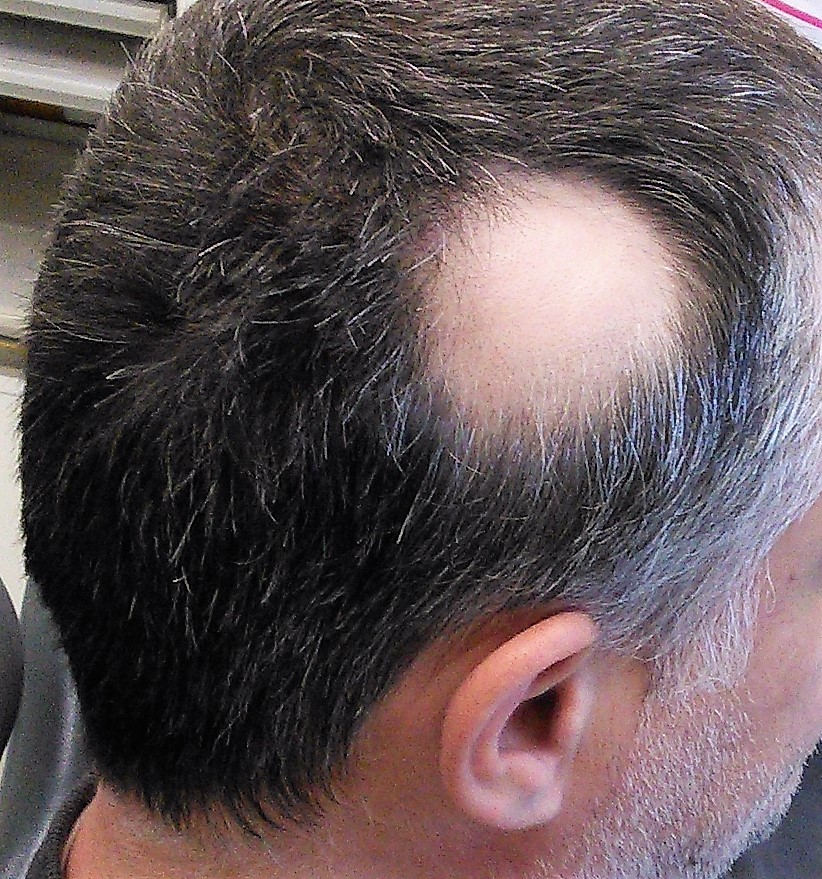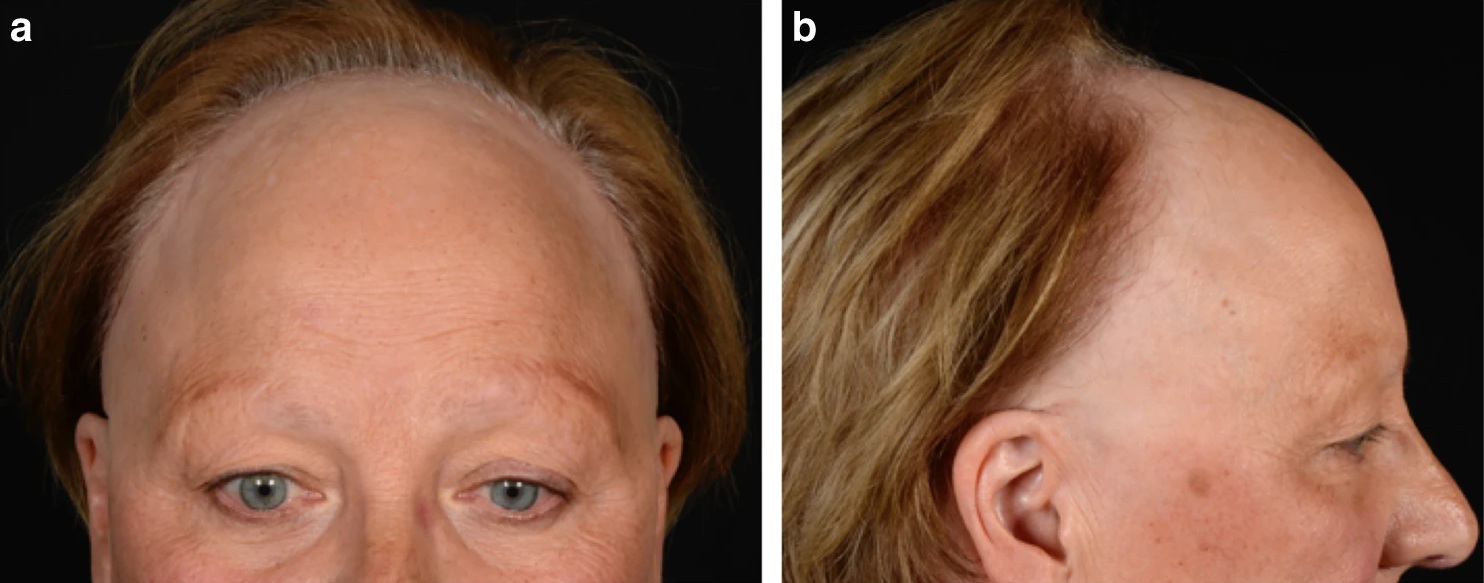Millions of people around the world are affected by hair loss. Experiencing hair thinning or falling out can be very upsetting, and it’s only natural that people will flock to the internet in search of a remedy. Of course, we’d always recommend seeking professional medical treatment; but in order to offer the best advice, doctors first need to figure out what’s causing the hair loss, and there are more possibilities than you might think.
For many of us, when we imagine “hair loss” we’re thinking of a condition called androgenetic alopecia. It’s commonly referred to as male pattern baldness because in men it tends to occur in a very consistent pattern across the head, leaving a ring of hair around the bottom of the scalp. But this type of hair loss also affects women, who may see more generalized hair thinning all over the head.
It’s the most common type of hair loss and can progress over many decades. In men, it often eventually leads to complete baldness, but that’s not as typical in women.
Although androgenetic alopecia is so common, its causes are still not fully understood. It’s thought to be down to a combination of genetic and hormonal factors. Having a close relative with the condition appears to be a risk factor.
Another type of hair loss that many of us will be familiar with is chemotherapy-induced alopecia. Chemotherapy uses powerful drugs to target fast-growing cancer cells, but it commonly causes side effects as other cells within the body get caught in the crossfire. One of the more well-known of these is hair loss, but it’s important to remember that not every chemotherapy regimen will cause this, and not everyone reacts to treatment in the same way. Hair will typically grow back when treatment is finished, although it may have a different color or texture than before.
A third type of hair loss that receives more widespread attention is traction alopecia. This can be caused by hairstyles that place a lot of tension on the hair follicles, like tight braids or hair extensions. Over time, the constant pulling on the hair causes it to thin and fall out in patches. If caught early, the hair can grow back if the hairstyles are stopped; however, over time, traction alopecia can cause permanent destruction of the follicle, which is seen as a smooth, shiny appearance of the scalp.
These are some of the more well-known causes of hair loss, but there are plenty of others. Here are a few that you may not have come across.
Alopecia areata
Alopecia areata (AA) is an autoimmune condition causing sudden, patchy hair loss, though it’s still not understood why the immune system starts to attack the body’s healthy hair follicles in this way.
“We have some ideas about what causes AA, and some limited research evidence, but the short answer is we don’t know – at least not with complete confidence,” explained Professor Kevin McElwee from the University of Bradford Centre for Skin Sciences in a blog post for Alopecia UK.

Example of the typical patchy hair loss associated with alopecia areata.
McElwee explained that possible causes include genetic factors: “So far there are at least 15 candidate gene sequences […] that probably have an influence on AA.” As well as that, there are likely environmental triggers at play. Some people develop AA suddenly after a very stressful event. Hormones can also be a factor, and there’s intriguing evidence to suggest a potential link between AA and allergies too.
There are different subtypes of AA depending on the pattern of hair loss observed; alopecia totalis, for example, is the complete loss of all hair on the scalp, while alopecia universalis is the loss of all hair on the body, including eyelashes.
In some people, the hair can regrow fully, and some can experience cycles of loss and regrowth throughout their lives. In cases of alopecia totalis or universalis, full regrowth is less common.
There’s no cure for AA, but a variety of different treatments can be tried, generally with mixed results. It can take some time to find a treatment that works for an individual, and some people see spontaneous hair regrowth with no treatment at all.
Telogen effluvium
It’s normal and healthy for hair to shed as part of its growth cycle – most of us lose between 30 and 150 hairs per day. However, when this cycle gets out of whack, you can end up with more hairs in the shedding phase than usual, leading to hair thinning. This is called telogen effluvium.
There are lots of reasons why the hair’s growth cycle can be altered in this way. Childbirth is one, as well as menopause, but also stressful life events, major episodes of illness or injury, extreme weight loss, skin conditions affecting the scalp, or starting a new medication. In one 2023 study, 61.4 percent of a group of women who had been infected with COVID-19 experienced hair loss afterwards, of which over 60 percent of cases were put down to telogen effluvium.
In about 30 percent of cases, however, no cause can be found.
You won’t see the hair loss immediately, as hairs spend several months in the telogen phase, so it will probably only become noticeable around two to four months after the triggering event. The hair will also continue to grow during this time; it’s just that more hair than usual has entered the “falling out” stage of the growth cycle.
Generally, the condition will resolve itself after around six to nine months, with no treatment required for most people.
Cicatricial alopecia
Cicatricial alopecia, or scarring alopecia, differs in a key way from the other types of alopecia mentioned above in that it causes permanent hair loss. With this group of conditions, the hair follicles are damaged, leading to scarring and no new hairs growing.
Cicatricial alopecia is an inflammatory condition. The causes are not totally understood, but according to the Alopecia Center of Excellence at Mount Sinai, it’s thought that an inflammatory process destroys the stem cells and oil glands of the hair follicles.
“The different forms of primary cicatricial alopecia all share a final pathway of areas of complete hair loss that make it impossible to distinguish many of them from each other,” explains a 2013 review in the Canadian Medical Association Journal.
One type is central centrifugal cicatricial alopecia (CCCA), which is most commonly seen in women of African descent. Hair loss in CCCA begins in the middle of the scalp and gradually spreads out. While many forms of alopecia are painless, CCCA can cause itching or pain in the scalp, as well as changes in the skin texture.
Some treatments may be effective at stopping or slowing the spread of CCCA, but as with other forms of cicatricial alopecia, once the hair is lost, it cannot regrow.
Alopecia UK explains that while the causes of CCCA remain unknown, there could be a genetic component in some cases. There’s also been a suggestion that it may be linked to hair styling practices involving chemical relaxers, traction, or heat.

Typical appearance of another subtype of cicatricial alopecia called frontal fibrosing alopecia.
Another subtype is frontal fibrosing alopecia (FFA), where the hair loss affects the front of the scalp or hairline, and often the eyebrows. FFA is thought to be an autoimmune condition and is usually progressive. There are no known effective treatments, and the condition is most common in post-menopausal women.
Trichotillomania
To conclude, we need to look at a type of hair loss that stands out from all the rest we’ve mentioned.
Trichotillomania falls under an umbrella of mental health conditions called body-focused repetitive behaviors (BFRBs). Also known as the “hair pulling disorder”, people with trichotillomania will compulsively and repetitively pluck hair from their own scalps or other areas on their bodies. Like other BFRBs, such as skin picking, the condition is considered to be related to, but distinct from, obsessive-compulsive disorder.
The condition typically arises between the ages of 10 and 13 years old. The urge to pull out the hair can be very intense and impossible to resist, and the act of hair pulling tends to offer a sense of relief. It can profoundly affect patients’ quality of life, causing feelings of shame and embarrassment as well as self-consciousness about the hair loss.
If trichotillomania is combined with habitual chewing on or eating of hair (trichophagia), this can have more serious health consequences – a 2021 case report described a 17-year-old patient who developed a trichobezoar so large that it perforated her stomach. That’s essentially the human equivalent of a furball, a mass of hair that can’t be broken down in the digestive system.
Trichotillomania is usually not treated with drugs, but with a form of cognitive behavioral therapy called habit reversal training. This aims to help patients replace the habitual hair pulling with another behavior that is less harmful, such as squeezing a stress ball or using a fidget toy, as well as learning their triggers and how to avoid them.
Last word
That was a whistle-stop tour through some of the lesser-known causes of hair loss, but even this is not an exhaustive list. If you’re concerned about hair loss or thinning, the best place to start is with your dermatologist or family doctor, who will hopefully be able to investigate potential causes and set you on the right path to managing the condition.
The content of this article is not intended to be a substitute for professional medical advice, diagnosis, or treatment. Always seek the advice of qualified health providers with questions you may have regarding medical conditions.
All “explainer” articles are confirmed by fact checkers to be correct at time of publishing. Text, images, and links may be edited, removed, or added to at a later date to keep information current.
Source Link: Genes, Hormones, And Hairstyling – Here Are Some Causes Of Hair Loss You Might Not Have Heard Of